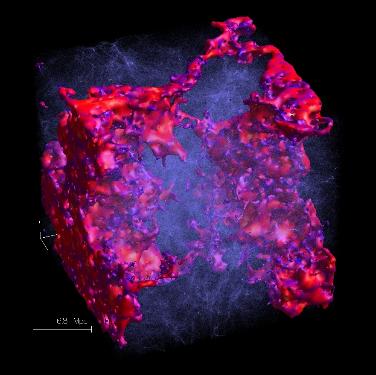Just after the Big Bang, the background temperature was high enough to maintain the baryons in a plasma state, then it dropped due to the adiabatic expansion of the Universe. About 400 000 years after the Big-Bang, protons recombined with free electrons to form neutral hydrogen atoms : this is the first phase change of the Universe. The Cosmic Microwave Background (CMB) radiation emitted during this recombination tells us that the structure formation in the Universe originated from a very homogeneous density field. Then the Universe entered the Dark Ages, which last until the first bound objects are formed and emit the first light. The first stars were embeded in mostly neutral InterGalactic Medium (IGM), but the UV radiation from the first stars started to reionize the IGM. This is the second phase change of the Universe, from neutral to ionized state (when the Universe was between 1 and 7 percents of its age), called the epoch of reionization.

The reionization epoch starts at the birth of the first stars. We do not know exactly when the first stars are formed, this is not given in the simulations, by lack of dynamics and spatial resolution. The end of the reionization should occur at redshift z 6, as shown by the observation of remote quasar absorption spectra, revealing a completely ionised IGM after this redshift. Observing and exploring the IGM during the reionization epoch is very important to reveal how the first stars and first quasars were formed.
The 21 cm radiation*, emitted at the transition between the singlet and the triplet state of the hydrogen atom in its fundamental energy state, is excellent to explore the IGM during the reionization, because the IGM is composed of 75% of hydrogen and 25% of helium (in mass). Since the 21 cm radiation is optically very thin, it propagates through dust and gas clouds without being absorbed or scattered. It is very useful to study the topology and other properties of the IGM during the reionization. In the next decade, large metric radio-interferometers (LOFAR, MWA, SKA) will start to operate and observe the 21 cm signal at these high redshifts (z=6-11).

Modelling the signal through numerical simulations prior to the observation is an essential step in order to optimize the design of instruments and the data analysis. The team of Paris Observatory predicted the 21 cm signal during the reionization through radiative transfer simulations. Physical knowledge is required of many parameters of the IGM as well as the source properties, to derive the 21 cm signal : the density field, the velocity, the ionization fraction, the kinetic temperature, the local flux of Lyman-alpha photons of hydrogen, etc.... All these elements were estimated with less approximations then previous studies, to produce a more exact map of the 21 cm signal during reionization. This showed that the inhomogeneous local Lyman alpha flux multiplies the amplitude of the 21 cm signal by a factor 10, with respect to previous work assuming homogeneous Lyman alpha photons flux. These results imply that observations of the early reionization (z>10) will probably benefit from a higher signal-to-noise value than during later stages. In addition, different spectra of ionizing sources were considered, modifying the statistical properties of the 21 cm. Observations will constrain the nature of the first sources.
* Note : In fact, this is a forbidden transition which has very poor probability, but we can observe it thanks to the large amount of hydrogen atoms on each line of sight.
Reference
S. Baek, B. Semelin, P. Di Matteo, Y. Revaz, F. Combes, 2010, Reionization by UV or X-ray sources, A&A in press
Contact Sunghye Baek (Scuola Normale Pisa, Italy & Observatoire de Paris, LERMA)
Benoit Semelin (Observatoire de Paris, LERMA, et CNRS)
